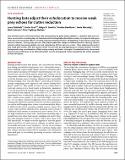Files in this item
Hunting bats adjust their echolocation to receive weak prey echoes for clutter reduction
Item metadata
| dc.contributor.author | Stidsholt, Laura | |
| dc.contributor.author | Greif, Stefan | |
| dc.contributor.author | Goerlitz, Holger R. | |
| dc.contributor.author | Beedholm, Kristian | |
| dc.contributor.author | Macaulay, Jamie | |
| dc.contributor.author | Johnson, Mark | |
| dc.contributor.author | Madsen, Peter Teglberg | |
| dc.date.accessioned | 2022-06-27T16:30:09Z | |
| dc.date.available | 2022-06-27T16:30:09Z | |
| dc.date.issued | 2021-03-03 | |
| dc.identifier | 280217908 | |
| dc.identifier | 531e2052-8051-4560-b8ee-daeddec92698 | |
| dc.identifier | 85102079476 | |
| dc.identifier | 33658207 | |
| dc.identifier.citation | Stidsholt , L , Greif , S , Goerlitz , H R , Beedholm , K , Macaulay , J , Johnson , M & Madsen , P T 2021 , ' Hunting bats adjust their echolocation to receive weak prey echoes for clutter reduction ' , Science Advances , vol. 7 , no. 10 , eabf1367 . https://doi.org/10.1126/sciadv.abf1367 | en |
| dc.identifier.issn | 2375-2548 | |
| dc.identifier.uri | https://hdl.handle.net/10023/25567 | |
| dc.description | This study was funded by the Carlsberg Semper Ardens grant to P.T.M. and by the Emmy Noether program of the Deutsche Forschungsgemeinschaft (DFG; German Research Foundation, grant no. 241711556) to H.R.G. All experiments were carried out under the following licenses: 721/12.06.2017, 180/07.08.2018, and 795/17.05.2019. | en |
| dc.description.abstract | How animals extract information from their surroundings to guide motor patterns is central to their survival. Here, we use echo-recording tags to show how wild hunting bats adjust their sensory strategies to their prey and natural environment. When searching, bats maximize the chances of detecting small prey by using large sensory volumes. During prey pursuit, they trade spatial for temporal information by reducing sensory volumes while increasing update rate and redundancy of their sensory scenes. These adjustments lead to very weak prey echoes that bats protect from interference by segregating prey sensory streams from the background using a combination of fast-acting sensory and motor strategies. Counterintuitively, these weak sensory scenes allow bats to be efficient hunters close to background clutter broadening the niches available to hunt for insects. | |
| dc.format.extent | 9 | |
| dc.format.extent | 1384657 | |
| dc.language.iso | eng | |
| dc.relation.ispartof | Science Advances | en |
| dc.subject | QH301 Biology | en |
| dc.subject | DAS | en |
| dc.subject.lcc | QH301 | en |
| dc.title | Hunting bats adjust their echolocation to receive weak prey echoes for clutter reduction | en |
| dc.type | Journal article | en |
| dc.contributor.institution | University of St Andrews. School of Biology | en |
| dc.identifier.doi | 10.1126/sciadv.abf1367 | |
| dc.description.status | Peer reviewed | en |
This item appears in the following Collection(s)
Items in the St Andrews Research Repository are protected by copyright, with all rights reserved, unless otherwise indicated.

